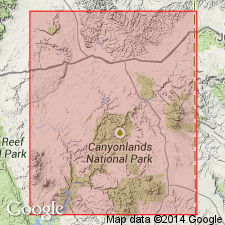
- Usage in publication:
-
- Tidwell Member*
- Modifications:
-
- First used
- Areal extent
- AAPG geologic province:
-
- Paradox basin
- Piceance basin
Summary:
Is the basal member of Morrison Formation in the Paradox and Piceance basins above the regional unconformity, J-5, and below Salt Wash Member of Morrison. Composed of reddish-brown to bluish-gray siltstone and shale, and at base brown, flat to wavy, thin-bedded, coarse-grained sandstone in a measured section near Duma Point, UT sec 30, T23S, R18E where it is 10-8 m thick and lies between Summerville Formation and Salt Wash. Duma Point is 2.3 km north of Lupton's (1914) type Salt Wash. Tidwell also contains rounded limestone nodules and gray limestone. Averages 17.2 m thick; ranges from 4.8 kn to 28.6 km. Is a slope-former. Is found over wide area of CO and UT east from San Rafael Swell to Bridgeport and Uravan, Co and south to Kaiparowits Plateau and Henry Mountains, UT. Near Glenwood Springs, CO Salt Wash wedges out and Tidwell merges with main part of Morrison. These rocks may have been included in Summerville by some earlier workers. Of Late Jurassic age.
Source: GNU records (USGS DDS-6; Denver GNULEX).
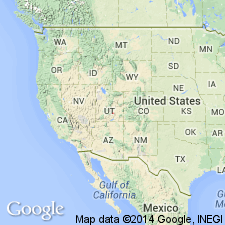
- Usage in publication:
-
- Tidwell Member
- Modifications:
-
- Geochronologic dating
- AAPG geologic province:
-
- Paradox basin
Summary:
Samples taken from bentonites and bentonitic mudstones in Morrison Formation near Notom, Wayne Co, UT in Paradox basin show that Morrison at this locality is post-Kimmeridgian, Tithonian or Late Jurassic, Neocomian to Albian or Early Cretaceous age. Fission-track data on zircon from one sample of the Upper Jurassic Tidwell, basal member of Morrison, at Notom yielded an age of 157 +/-7 Ma. The sedimentation rates for Tidwell as well as overlying Salt Wash and lower part of Brushy Basin Members were about 6.2 m/m.y., whereas the sedimentation rate for upper part of Brushy Basin was only about 0.6 m/m.y. The reduction in sedimentation rate in late Morrison time was probably related to reduction in plutonic activity caused by slowing of collision at about 140 to 145 m.y. between the North American and Farallon plates.
Source: GNU records (USGS DDS-6; Denver GNULEX).
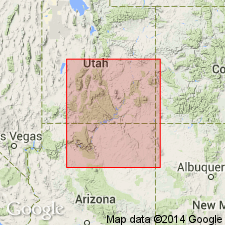
- Usage in publication:
-
- Tidwell Member*
- Modifications:
-
- Named
- Dominant lithology:
-
- Mudstone
- Sandstone
- Gypsum
- AAPG geologic province:
-
- Paradox basin
- Plateau sedimentary province
Summary:
Named as basal member of Upper Jurassic Morrison Formation for Tidwell Bottoms, a marshy area along San Rafael River, Emery Co, UT, Paradox basin. Occurs throughout most of Colorado Plateau. Called Tidwell unit in earlier reports. Type section designated and measured in NE1/4 SE1/4 SE1/4 sec 24, T22S, R13W. Is 29.3 m thick at type where it overlies Summerville Formation unconformably (J-5) and underlies and interfingers with Salt Wash Member of Morrison. Consists of grayish-green to dark reddish-brown, calcareous mudstone that may be laminated or very thin-bedded, and gray, very fine- to fine-grained, laminated to very thin-bedded or small scale cross-bedded sandstone, and white nodular gypsum beds, some up to 14 m thick. Some thin beds of gray, dense limestone. Mudstone predominates. Ranges from 0-89 m thick. Type Morrison resembles Tidwell. Red mudstone dominant on west side, Henry and Kaiparowits basins, Plateau sedimentary province. Has authigenic red and (or) yellow chert in small blebs (1-2 m diameter) or in nodules and concretions usually 7-11 m above base. Base marked by chert at some localities. Has some light-gray to white cross-bedded sandstone of eolian origin with dip vectors oriented due east to northeast. Deposited in lacustrine, evaporative, mudflat and fluvial environments. Of Late Jurassic age. Palynomorph and alga fossils. Cross sections.
Source: GNU records (USGS DDS-6; Denver GNULEX).

- Usage in publication:
-
- Tidwell Member*
- Modifications:
-
- Areal extent
- AAPG geologic province:
-
- Paradox basin
Summary:
Name extended to area of Kane Springs, San Juan Co, UT to Uravan, Montrose Co, CO, Paradox basin. Rocks here assigned to Tidwell Member of Morrison Formation or to Wanakah Formation have been previously assigned to Summerville Formation (not used) by other workers. [Rocks assigned to Summerville by other workers in area of Slick Rock, San Miguel Co, CO to Uravan, CO in Paradox basin are also included with Tidwell or Wanakah Formation by O'Sullivan (1989, USGS OC-133).] Much of Summerville is truncated beneath J-5 unconformity about 20 mi northwest of Moab, UT (northwest of study area). Overlies Wanakah; underlies Salt Wash Member of Morrison. Late Jurassic age.
Source: GNU records (USGS DDS-6; Denver GNULEX).
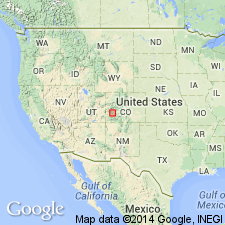
- Usage in publication:
-
- Tidwell Member*
- Modifications:
-
- Areal extent
- Age modified
- Reference
- AAPG geologic province:
-
- Paradox basin
- Piceance basin
- San Juan Mountains province
Summary:
Recognized as the basal member of Morrison Formation in Telluride-Ouray and Black Canyon of Gunnison areas which are in southwest CO in Paradox and Piceance basins and in San Juan Mountain province. Thickens north from 50-70 ft in Telluride-Ouray areas and 105-210 ft in Black Canyon. Forms a slope between underlying "beds at Sawpit", the upper beds of Wanakah Formation, and the overlying Salt Wash Sandstone Member of Morrison. Lower contact is at the J-5 unconformity at top of Wanakah Formation. Upper contact is at base of lowest thick channel sandstone of Salt Wash. Reference section 163+ ft thick measured and designated on east-facing cliffs of Gunnison River, western Black Canyon, Montrose Co. Divisible informally into 1) bed A (a conspicuous gray to white, fine-grained, flat-bedded, ripple-marked sandstone), 2) lower slope-forming gypsiferous beds (which is mostly sandstone and siltstone but has gypsum throughout as thin, crosscutting seams, nodules, disseminations; locally has 22 beds of gypsum), 3) upper beds (gray, slope- and ledge-forming sandstone, siltstone, and limestone). The upper beds include the separately distinguishable bed at Smith Fork. A limestone bed near top of upper beds has a ECHINOCHARA SPINOSA which indicates Kimmeridgian age--a modification of Late Jurassic age. Several eolian sandstones present in upper beds. Considered Kimmeridgian, Late Jurassic age. Cross sections; nomenclature chart.
Source: GNU records (USGS DDS-6; Denver GNULEX).
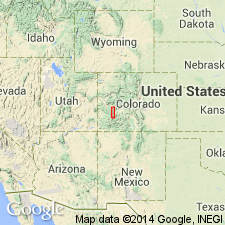
- Usage in publication:
-
- Tidwell Member*
- Modifications:
-
- Areal extent
- AAPG geologic province:
-
- Piceance basin
Summary:
Some of the nomenclature assigned to Jurassic rocks in the western Black Canyon at the Smith Fork of the Gunnison River, Gunnison Co., CO, Piceance basin is revised. Rocks previously assigned to the upper part of the Wanakah Formation are reassigned to the lower part of the Morrison Formation of Late Jurassic age. In previous reports on this area, Wanakah was thought to underlie Salt Wash Member of Morrison. In this report, the name Tidwell Member of Morrison is applied to the former upper Wanakah. Tidwell is divisible into (ascending): bed A, lower gypsiferous beds, and upper beds, Tidwell overlies "beds at Sawpit" at top of Wanakah beneath the J-3 unconformity and underlies Salt Wash Member. The unit "bed at Smith Fork" which lies in the middle part of the upper beds of the Tidwell replaces use of name Junction Creek Sandstone for the 73 ft thick, gray to white, fine grained, cross-bedded sandstone. The bed at Smith Fork pinches out southward; it is not present at South Smith Fork measured section; it dips under younger rocks less than 1 mi east of Smith Fork measured section. Cross section.
Source: GNU records (USGS DDS-6; Denver GNULEX).
For more information, please contact Nancy Stamm, Geologic Names Committee Secretary.
Asterisk (*) indicates published by U.S. Geological Survey authors.
"No current usage" (†) implies that a name has been abandoned or has fallen into disuse. Former usage and, if known, replacement name given in parentheses ( ).
Slash (/) indicates name conflicts with nomenclatural guidelines (CSN, 1933; ACSN, 1961, 1970; NACSN, 1983, 2005, 2021). May be explained within brackets ([ ]).

